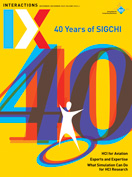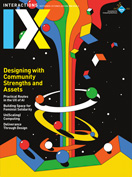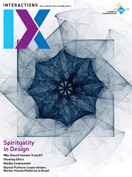Authors:
Lucy Pei, Edgard Quijano, Angela Smith, Reem Talhouk, Frederick van Amstel
This article provides views from HCI scholars and designers with deep commitments and varied experience in community-centered work around the world. In a roundtable, Frederick van Amstel, Edgard David Rincón Quijano, Angela D.R. Smith, and Reem Talhouk shared their perspectives on community engagement and assets-based versus deficit-based approaches. — Lucy Pei
How would you characterize your community engagements? What key values have you aspired for in your engagements?
→ The panelists from around the world have culturally and contextually specific ways of understanding their community engagements.
→ Panelists argue for embracing strengths and assets and moving away from a deficit narrative without losing sight of the urgency of needs that communities face.
Frederick van Amstel: Our Laboratory of Design Against Oppression (LADO) at Universidade Tecnológica Federal do Paraná typically starts new projects by working with communities that our students are already part of, or by working with communities that seek our partnership. Our student researchers act as brokers working with communities, academics, and other groups in each project. When they do not know a community, they respectfully join its activities and try to understand them as if they were an insider. That understanding takes time to develop, as it depends on establishing authentic relations with community members. If the researcher already has such relations, it is possible to skip these initial steps and move to the negotiating proposals phase. In this phase, the community tries to understand how the researcher's design knowledge could contribute to strengthening its activities. This phase rarely ends with a clear plan, yet we always find a thread to pick up. As the researcher gains responsibility, the problematizing phase starts. Instead of solving the problem or fulfilling the need expressed by community members, the researcher tries to find the historical contradictions behind these problems and needs. In this laboratory, we develop the skill of tracing design problems to oppression and its contradictions, which can mobilize liberation efforts that have the potential to transform the community's reality. There is always a history of liberation fights that we can connect to, even if they are dormant at that moment. The final phase consists of articulating or joining creative insurgencies against oppression. Throughout this process, we try to be very sensitive to the community's existential time: what the community claims to have been in the past, what it currently strives to be, and what it dreams of becoming. Since we are dealing with transforming reality, the most important design quality for us is historicity, which refers to the extent to which present projects are well-grounded in past and future projects.
Edgard David Rincón Quijano: I believe that the community commitments I have been assuming correspond to three categories or roles: social designer, facilitator of processes, and agent of change. It is very likely that these roles are part of a legacy, since my parents and grandparents were educators who were always committed to bringing training as part of a process of self-actualization and societal transformation. First, as a social designer, I seek a particular approach to receive commissions whose scale corresponds to community and communal problems and incorporate this approach into other commission types. Second, I believe it is vital to recognize oneself as immersed in a community. It is important to prioritize the community evolution process over the specific design domain. Planning and supporting the execution of the processes of design, and engaging and sharing these processes, is what makes a community initiative possible. We do this through facilitating and planning workshops and codesign and cocreation sessions, supporting participatory design processes, and following up on advanced processes with the design of instruments and procedures. Third, "preach and not practice" is a fallacy that will be called out by those you hope to engage with, so it is vital to have your own cause. There are multiple mechanisms through which to make these changes; in my case, I chose to carry out a social enterprise in using solid waste from construction and demolition. The project allows the creation of jobs and income while also generating social and environmental impact. Being an entrepreneur offers the possibility of focusing energies on the creation of incorporated knowledge and learning from the challenges at the community level within the neoliberal market schemes.
This issue of Interactions focuses on the idea of design based on community assets and strengths, as opposed to deficits, as a driving force for community engagement. In your experience, have you encountered a default mode of community engagement that centers on deficits and needs? What are the strengths and weaknesses of this approach?
Angela D.R. Smith: It is largely impossible to not encounter certain community engagements that center deficits and needs. For so long, this approach has been ingrained in our societal and professional practices. For me, working with individuals experiencing houselessness and houseless shelter networks has illustrated how deficit thinking is rooted in victim-blaming. Further, deficit thinking suggests that people are responsible for their predicament and fails to acknowledge that they live within coercive systems that cause harm with no accountability. Deficit thinking is not only a symptom of larger systemic oppression but also reinforces these systems. I discussed this concept in my dissertation through the lenses of information poverty and information marginalization. There has to be an onus on researchers and scholars to recognize the agency and capacity of historically excluded individuals while also challenging the systemic influences on their ability to succeed.
In regard to nonprofits and community-based organizations, they are often in precarious situations. When I think of individuals experiencing houselessness and the organizations trying to support them, it is difficult to solely push strength-based and assets-based approaches. When organizations solely push assets-based narratives and framings, it is challenging for society to recognize that there is a problem and why there is a need for resources. Also, it's challenging for the individuals experiencing it, because there is nuance in every situation. There are many supports required to overcome system-caused obstacles and challenges and not everyone can access them. Lastly, I think the question becomes: If we do not name the harm that has been done and assign responsibility, are we shifting the narrative—challenging the assumption that certain populations and communities are bringing this upon themselves?
The way to avoid the problem of having the struggles of individual people or places represent something inherent and immutable is to explicitly point out the systems at work—past and present—that cause them. If you're talking about a problem, we must use language that reflects that systematic disparities and community-wide problems in fact have systemic causes, that harm has been done, and that these are not self-caused problems, and explicitly describe those systems whenever possible.
Reem Talhouk: I think it is safe to say that in humanitarian and global development work, a deficit-based approach is the default mode and that critiques of this approach are abundant. I am not going to delve into those critiques but rather point to an incident that occurred when working with a Syrian refugee community in Lebanon. When we were cocreating a booklet around their experiences of food insecurity, participants made it very clear they wanted the booklet to show their experiences of food insecurity (i.e., needs) but equally their resilience and ways of coping with food insecurity. They viewed their knowledge of coping with food insecurity to be an asset that they wanted to share with other refugees through the booklet. Their approach to making the booklet really showed that needs and assets are not mutually exclusive. In the lived experience of refugees, both needs and assets are interwoven.
The humanitarian system does have a duty of care toward refugees because it is global geopolitics (neocolonialism), colonialism, and environmental policies that have contributed to the mass and prolonged displacement of people and to the inequities they experience. That being said, reducing the narrative to a needs-based one in effect reduces refugees to reflections of their needs rather than promoting them as agents with assets within the system. As such, I would argue that we can engage in both approaches simultaneously because in reality refugee experiences are shaped by their needs and assets, among other things.
EDRQ: I see myself as someone who prefers the appreciative approach over the deficit approach. However, I have often found that promoting this idea is difficult for people involved in community work initiatives. Contexts have developed from deficit framings that operate to preserve hegemonic positions and patronage. In the case of Colombia, it is easy to find communities that have been characterized within the deficit scheme. For years, we have worked under the multidimensional poverty scheme in Colombia, which requires mapping and assessing the current state of families. Many of the indicators available to carry out this initial assessment focus on deficits: They are absolute indicators—yes or no—that imply there is only one possible satisfier of needs. For example, it is considered relevant whether there is no separation between the social and private areas of the house as an indicator of poverty. However, this may ignore ways of inhabiting ancestral and emerging urban cultures where such a division of space is not relevant. Indicators are formulated so that people can access subsidies and offers from the state, which were conceived without recognizing other ways of living.
Such blunt indicators label Colombia as a place of poverty, violence, and informal employment. These definitions are based on Colombia's lack of status quo living conditions that homogenize and colonize. Little is said about baselines where there are community assets, or the diversity of what different communities might value. Nor are there processes that begin by assessing what exists outside the concept of heritage: assets, obligations, and rights. Deficit approaches impose a way of life, inherited from a colonial frame: The master shows the community's deficiencies to maintain control over the oppressed by the example of his way of life. Deficits are simple and forceful indicators, as opposed to the complexity of understanding an issue through an uncertain and open-ended inquiry, full of extensive descriptions and with uncertainties.
In your work, how have you engaged with community assets and strengths? Do you engage with them more explicitly, or implicitly?
FvA: The best translation for the word asset in Portuguese, ativo, brings forth a narrow economic meaning that would not make sense to use in our community engagements. As for the word strength, of course we use it to fight oppression. Nevertheless, in the context of a fight, we cannot only focus on the community's strengths. On the one hand, we need to recognize the community's weakness and avoid exposing that to the oppressors. But on the other hand, we need to find the oppressors' weakness to change the rules of the rigged games that make the community lose most of the time. For example, oppressors typically become more reasonable negotiators once we draw attention to what their ancestors have done to curtail the community in the past. Turning strengths into weaknesses by denouncing unjust privileges on the oppressors' side is also a way to realize that weaknesses can become strengths at the community's side. Oppressed communities typically have low self-esteem due to judging themselves as underdeveloped, uneducated, unequipped, or simply ugly in relation to their oppressors. From the moment the community looks at its history from an appreciative perspective, the same motives that generated shame can now generate pride. That is not just a matter of finding the community assets but also of changing the way they look at them. That is why we prefer to use the concept of handiness (amanualidade) to refer to the things that a community has at hand to develop further. These things are there because the community worked hard to make them available in the past, so we should not ignore such embodied intentions. Instead, we strive to support autonomous handiness development in our community engagements, even if that means using technologies an oppressor would judge outdated. From LADO's standpoint, the most advanced technology is the one that the community can use for its self-benefit. We see so many laboratories trying to bring supposedly advanced technologies to underprivileged communities that fail miserably, at least in terms of fighting oppression. We cannot afford to do that. That is why we need to be very keen on the community's handiness when designing something. This reflection will often move us from designing with to designing by, or in other words, infrastructuring the design that the community is already doing.
RT: My Ph.D. research drew on the concept of community resilience, both critiquing and reenvisioning it with participants through codesigning humanitarian technologies; therefore, the research inherently engaged with community assets and strengths, which are elements of community resilience. However, engaging with community assets and strengths was done implicitly. The reason for that is upon starting the research, I did not want to assert the narrative of "You as community have assets that we can design from and with," because I was unsure how participants felt about that, or what within their community they viewed as assets. So, the starting point of the engagements was neither needs nor assets, but rather their individual and shared narratives of their experiences and relationships with each other and people outside the community. And as participants coconstructed their shared narratives, we were able to identify that they already leverage their knowledge and the communal as an asset to navigate food insecurity. Indeed, they highlighted how they provide advice to one another on how to cook on a budget, where to shop, and so on. They also relied on the communal to organize collective transportation and to buy items in bulk. We were then able to critically examine existing food aid technologies and their ability to further support the use of the aforementioned assets and found them lacking, thus prompting us to reenvision how these technologies may be designed around and with their assets.
ADRS: In my work, I have engaged both implicitly and explicitly with a community's assets and strengths. In my most recent research, I explicitly engaged with the strengths of my population of interest—emerging adults ages 18 to 24 experiencing homelessness within the local homeless shelter network—with regard to their information-seeking behavior. I sought to understand their specific strengths in order to address how the shelter can acknowledge and continue to build off these strengths through various sociotechnical interventions. When I say "explicit," I mean my population's strengths were the foci of my proposed interventions, for example, curriculum, technological tools, and so on.
In a previous study, I partnered with an organization that sought to understand how to reconnect opportunity youth—young people ages 16 to 24 who are disconnected from educational and employment opportunities—through the various programs and initiatives across Chicago. In this study, I conducted focus groups across different neighborhoods of the city to understand how participants engage with these programs and initiatives. In the focus group, we also mapped community assets and challenges to learn more about participants' lived experiences, perspectives, and concerns that led to and sustained their disconnection. While we did not explicitly prompt participants to identify community assets, participants naturally shared them while recounting their experiences and during the solutions brainstorming activity. When I say "implicit," we used assets to guide our final discussions, but they were not the main focus. The outcomes of this study were multilevel. First, the study illustrated how we can leverage existing assets to facilitate relationship-building and connections between educational and extramural support organizations. Second, it identified some of the greater systemic challenges at play affecting the success.
Community engagements have always been central to the ethos of HCI research and design. We hope this diverse set of ideas about the ways engagements can be done in different contexts inspires readers to consider assets as a starting point while recognizing the role that narratives of problems or even deficit and weakness can play in reaching community goals.
Lucy Pei is a Ph.D. candidate in the Department of Informatics at the University of California, Irvine. Her research is focused on understanding the dynamics and discourses of tech-for-good intervention, especially in the context of migration and forced migration. [email protected]
Edgard David Rincón Quijano is an assistant professor in the School of Architecture, Urbanism and Design at Universidad del Norte in Barranquilla, Colombia. He is coordinator of the Design for Social Innovation of the Caribbean Laboratory and a member of the DESIS network association. His research is about reflection as a resource in social transformation design. [email protected]
Angela D.R. Smith is an assistant professor in the School of Information at the University of Texas at Austin. Her research explores how intersectional identities of historically excluded communities and social positioning affect their interactions with technology and how to create equitable and socially responsible sociotechnical interventions. [email protected]
Reem Talhouk is a Vice-Chancellor's Research Fellow in design and global development at Northumbria University. She is codirector of the Design Feminisms Research Group and a member of CoCreate. Her research focuses on design and technologies in humanitarian contexts and decolonial design within this space. [email protected]
Frederick van Amstel is an assistant professor in the industrial design department at Universidade Tecnológica Federal do Paraná (UTFPR). He is also vice-coordinator of the Laboratory of Design against Oppression, a research and outreach unit at UTFPR concerned with the contradiction of oppression and the possibility of designing for liberation. [email protected]
Copyright held by authors
The Digital Library is published by the Association for Computing Machinery. Copyright © 2022 ACM, Inc.









Post Comment
No Comments Found